https://www.silverscalesflytying.co.uk/wp-content/uploads/2018/03/chriss-pics-396.jpg
A general guide to:
Locating and Fishing for Bass
You've decided to have a go at Saltwater fly fishing, you've bought all the necessary gear and you may have decided to tie your own flies as well. The next step is to go out and try and catch yourself a Bass!
Where do you start?
I see many novice 'SWFF 'ers' asking for help on the Internet and generally more experienced anglers are happy to help, however nothing really beats experience. The only way to catch Bass on the fly or indeed any other salty species is to get out there and start learning. Having said that, there are several things you can do before you venture out that will help.
The first thing is to get yourself a local Tide table. Many Tackle shops will have these or you can have a look on the internet. The next thing to do is to download Google Earth. I have found Google Earth to be an invaluable tool that has helped me in my own fishing no end. Google Earth allows you to look at your local coastline via Satellite imagery in fairly good detail. Sometimes you can clearly see what the sea bed is like if the images were taken on a calm day and the sea was clear. You can identify many features that will help you in your search for likely fish holding spots. If the Tide happened to be running when the image was taken you can often see 'rip lines' on the water or cloudy areas where the sea bed is being disturbed and where the rip stops and food is likely to be pushed to and where it drops out. The final thing to do is listen to the local sea fishing grapevine or ask in your local Tackle shop for information on areas that produce Bass to bait anglers, then go home and scan these areas on Google Earth to give you an idea of what is in front of you.
Before I go into more detail about how to locate Bass and fish for them let me talk about the fish themselves, their behaviour and their habits.
Bass are for the most part, ambush predators, especially the older and wiser and of course bigger they get. They would rather lie in wait for the their prey to come along than actively hunt and chase them. That is not to say that they are lazy fish but they would rather not expend unnecessary energy chasing prey if they can wait for it to come to them. There are exceptions to this for instance when there are large numbers of baitfish inshore. Bass will then see an opportunity to maximise on this and will actively herd their prey into certain areas where they are in concentrated numbers and the Bass can feed at will on the bountiful harvest available to them. The calorie reward is worth the energy expenditure...This is when you will see Bass 'Blitzing'; smashing the surface as they chase the prey into shallow water or to the surface to trap them, engulfing mouthfuls of tiny whitebait as they do. Bass will often regurgitate these meals when you catch them so you can have a look at what they are feeding on and match the hatch. You will often see Gulls joining in this gluttony and working above the surface of the water picking off and injured or dying fish on the surface. Clearly this is a dead giveaway from a locational point of view that there is something going on beneath the surface and should be investigated. Sometimes it can be Mackerel as well as Bass predating so always carry some smaller flashy flies in case because Mackerel make for great sport on the fly and fight miles above their weight on a fly rod! Often the Predators will drive the prey right in against the shoreline well within fly rodding distance, I have hooked fish almost right at my feet as they chase the fly in before hitting it! Sport can be fast and furious and it is possible to catch numerous fish in a short space of time!
In the absence of any obvious signs of predatory activity we have to resort to looking at other clues to help us locate potential fish holding areas.
We know that Bass would rather wait in ambush for the meal to come along but how is it going to find it's way to them?
The worlds Oceans are subject to a natural phenomenon known as Tidal pull. This is a force exerted upon the Oceans by our neighbouring Moons gravity. As the Earth rotates on it's axis the gravitational pull created works in conjunction with the Moons gravitational pull to create Tidal flow, causing the Oceans to ebb and flow.
Twice a day we have a flood tide where the sea runs in to land creating deeper water close in and twice a day we have an ebb tide where the water runs outward away from the land creating shallower water close in to shore. Each phase take roughly 6 hours give or take.
As the water ebbs and flows, the fish are forced to move with it, inward and outward. Tides vary in size according to the Moon phase, there will be greater movement of the water at certain times and less movement at others, these are called Spring Tides and Neap Tides. Springs being the larger of the two.
This movement of water is disrupted as it moves around or over any structure, both on the shoreline and beneath the surface, this is what creates 'rip lines'. Bass will take advantage of this disruption to lie in wait for prey to be caught up in the current created by the rip lines and swept along. They will seek out the slower water next to the rip or at the tail of it where they will lie in wait. The rip will be an obvious crease on the surface of the water, If you have ever fished a river the principle is exactly the same.
Bass congregate around these areas and it is possible several fish can be caught in a session. Visible structure that might disrupt the flow and create a rip line are, points of land jutting out into the sea, Piers and harbour walls, Breakwaters, moored boats.
Subsurface structure normally consists of boulders, weedbeds, underwater ledges, sandbanks.
This is by no means a comprehensive list and just intended as a guide to give you an idea of where to look. Look around your local shoreline and see if you can spot these rips and try and assess what they are created by.
Where I live we have a many varied coastline with all sorts of different ground, from general mixed ground to sandy beaches to boulder strewn rocky coves, and it is possible to catch Bass from virtually all these types of ground. Not all of these actually have visible rip lines nor can you always see water being disrupted by sub surface obstacles but it is possible to catch Bass from these marks with a bit of detective work. If your local beaches seem devoid of any structure above or below the surface, try walking them on a big low tide and noting any deviation in the bottom make up. This could be a gully, a change in the make up of the ground from shingle to mud, or rock to sand, a small ledge or plateau, anything that might be a fish holding area.
Bass will frequent many different areas seeking out opportunities to feed, but almost always with ambush in mind unless as previously mentioned there is a glut of preyfish.
There is not enough space here to write a fully comprehensive guide to locating Bass nor is it the right platform, so the best thing I can do is give you a few examples of some of my local marks and describe how I fish them, hopefully this will convey some ideas for your own coastline and finding the fish that will inhabit it.
Ten minutes from my house is a beach on the north coast of the Island, this is a popular beach with holiday makers and as such is fairly busy during the day. The times to fish here are early morning and evening into dark, when the beach is quieter, which as it happens are the best times to fish for Bass anyway. When the tide recedes on an ebb a small rock ledge is uncovered running for several hundred yards parallel to the shore. It is only a couple of feet high and is practically dry at low tide. As the tide floods, the water comes up and over this small ledge and it is necessary to wade out close to the front of it in order to fish. In a nut shell the fish hunt along this ledge, it is possible to catch fish both as the Tide floods over the ledge and as it ebbs back over it. They use the flood tide to trap any small prey fish up against it and the ebb Tide to lie in wait for prey to be swept back over the ledge and out to sea whereupon they seize them as they wash helpless and disorientated into the Bass that are lying in wait.
After some experimentation I have found that the Bass are more likely to be caught on the Ebb here, with the Flood being erratic in it's consistency at producing fish. This is simply because it is far easier for the Bass to ambush their meal on the Ebb tide and they have to do little other than lie in wait rather than actively hunting along the ledge seeking out food that way.
Another Mark I have fished, also on the north coast is a beach with soft muddy, clay bottom. To look at this beach at high tide is to think there is not much in the way of structure, or to appeal to Bass, however take another look at low tide and all is revealed..
There are several low lying gravel groins running out from the beach at right angles for 20 or 30 yards, and though they are not much to look at, when the tide is running the flow is disrupted over these stone groins creating only very subtle rip lines. I have found that Bass will lie in wait on the down tide side of these groins waiting for prey to be washed over them. Indeed they have proven to be a very reliable feature.
Another mark I fish is a shallow sandy beach, again on the North coast but there is a small estuary attached to the beach with a narrow boating channel leading to a harbour. I have caught many smaller Bass in this channel with the odd better one but it is always good fun. The Bass run this channel on both the flood and the ebb in search of food washing into and out of the harbour. The shallow sandy beach next door also produces fish and in the warmer months large shoals of schoolies herd that years whitebait in against the small sandbanks of this beach and sport can be fast and furious at times!
On the South Coast of the Island we have many more different areas that I fish and pretty much all of them hold Bass and it is possible to pin the fish down to small areas much as in the above examples, the difference here is that monsters lurk!
All of these venues produce fish at different stages of tide some early in the flood or ebb and some a couple of hours in or even towards the end. No two venues are the same and only by experimenting and fishing either the whole tide or certain stages will you uncover when you are more likely to catch on yours. The one thing they do all have in common is that they have something that is attractive to the fish and will enable them to find food of some sort. By spending time researching these marks I am giving myself the best chance of finding and catching Bass.
Welcome !
Pages
- Home
- Step by Steps EP Baitfish
- Step by Steps, Mylar Sandeel
- Step by step Mega Laser dub Baitfish
- Step by Step Mylar Sea Trout Candy
- Step by Steps Chris's Shrimp
- Step by Steps, Foam Grasshopper
- Step by Step Polar Flash mini Baitfish
- Step by Step Livebait Dubbing Baitfish
- Step by Step Barred Livebait Minnow
Thursday, 29 March 2018
Locating and Fishing for Bass
Sunday, 18 March 2018
Saltwater fly fishing- equipment recommendations
https://www.silverscalesflytying.co.uk/wp-content/uploads/2018/03/chriss-pics-364.jpg
In the previous two articles I covered the subjects of whether to tie your own flies and which one's to tie if you decided to have a go yourself. I have made the assumption so far that the reader is already suitably equipped to fish in the salt with regards to rod, reel, line etc. However I am going to back track a bit as I wasn't going to cover equipment in this series of articles but perhaps I should as it will give the novice a better idea of where i'm going when I move onto location and actually fishing your flies in the salt.
There is a plethora of opinion on what rods, reels and lines to use online, and for my two pence worth what I will say on that subject is spend as much as you can possible afford and then push your budget further because when it comes to fly fishing in the salt it does not pay to skimp on your equipment and you will only end up failing due to inadequate gear that makes the whole experience hard work and totally un enjoyable and will hinder the task of catching fish.
The first subject is Rods. Fly rods for Saltwater fly fishing must be robust, they MUST have Anodised fittings that are resistant to the savage corrosion that attacks normal rod fittings. Any metal parts on rings and reel seats will be subject to this if they are not saltwater proofed. I would always recommend washing all your gear down in fresh water after a session regardless but this is not always enough if the fittings on your rod are not salt proof. The higher the modulus of the Carbon the better. Weight wise an 8 or 9 weight rod is what you should be aiming at, preferably 9 feet in length and personally I would always recommend a fast actioned rod for the salt. Medium fast rods are ok and will cover most situations, and will be easier for a novice to learn to cast but modern fly lines suitable for the coast are leaning towards heavier than traditional ratings to cope with throwing a line out in coastal winds and the rod needs to be able to cope with that. As I have already mentioned it really does not pay to buy cheap with Saltwater rods, they simply will not perform adequately due to the lower modulus carbon used, unfortunately it is simply one area that cannot be compromised on.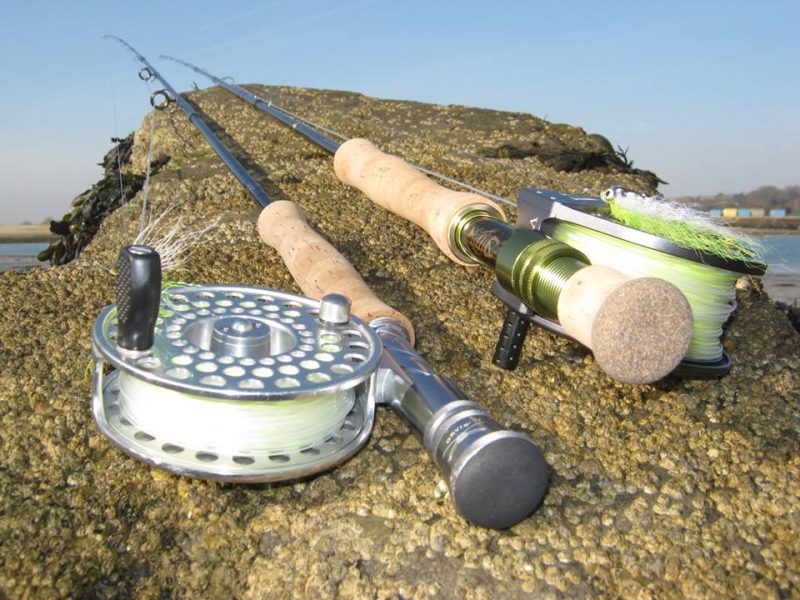
Reels are another item of equipment that must be Saltwater proof. As already stated the salt air and water will simply eat through any metal that is not anodised. Large arbour reels are ideal, and again try and spend as much as you can afford on this item so that it provides longevity as well as perform adequately. A good drag is useful as well as quality bearings that are shielded from water ingress.
Having Saltwater fly fished for numerous years I have come to realise that Line choice is probably THE most important aspect after Rod choice, in fact they must really be considered together, a mis matched rod and line will only work against you. I mentioned earlier that modern lines designed for coastal work are leaning towards heavier than traditional line ratings, what I mean is an 8 weight line designed for coastal use will actually be heavier than an 8 weight line designed for Trout or general use using the traditional 'grains' rating. The heads on coastal lines are shorter and denser so the weight is more concentrated allowing you to cast larger flies in strong breezes. Hence why I stated that a fast actioned rod is the best way to go, The heavier lines can over load lesser actioned rods causing the rod to run out of power and you end up with the cast collapsing around you. Casting on the coast is nothing like casting at a Trout lake or even for Pike, coastal winds can be cruel and unpredictable and if you haven't the set up to cope it will be a real struggle. I have always recommended Rio lines, but many people seem to find them too expensive and prefer to hunt down cheaper alternatives, but as with many things to buy cheap is to buy twice. You get what you pay for with fly lines as you do rods so don't say I didn't warn you! The Line needs to be extremely durable due to the rigours of salt water, it needs to have that short, compact, dense head of around 30-37 feet with a nice smooth running line to enable maximum distance. Depending on where you intend fishing and the depth of water you expect to find you should consider both a floating and intermediate line and if you're after Pollock in the deep water rocky coastlines of Ireland and Scotland then a sinking line is probably the order of the day! A floating line will cover depths up to 6-7 feet and an intermediate will serve well for up to 12 feet, any deeper and you'll need the full sinking line.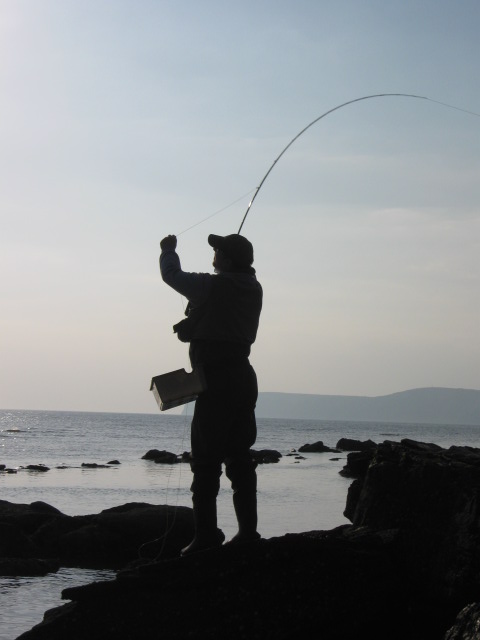
General equipment I use is a good fly vest, I have a Simms one which has served me well for many years and should go on for many more. Fly boxes need to be the water proof type especially if you spend much of your time wading as I do. Rogue waves will always catch you out soaking you and anything you happen to be carrying! Tools should again be as Saltwater proof as possible and I would always advise washing them after a session and even giving them a light coating of oil on any moving joints such as on scissors and forceps to keep them operating smoothly and keep corrosion out. Sun Glasses are essential both for eye protection as well as seeing into the water, more for wading on uneven ground than fish spotting but of course this can come in handy at times. A hat for me is another essential item, keeping the sun and weather off of your head. A good pair of waders will again be a solid investment, Salt water is cruel on waders and seems to make them deteriorate quicker than fresh water, Neoprenes for early season when the water is still relatively cold and breathable Nylon waders for the summer and autumn when the water is very warm or if you are walking long distances to fish. Boot or stocking foot is up to you but I prefer stocking foot because I tend to have long distances to walk to my marks and wading boots are easier on the feet than wellington style boots.
I always carry my mobile phone with me in a waterproof pouch where it is easily accessible in the event of an emergency should I get into any trouble while on the coast I can quickly summon help. It serves for this purpose and for taking picture records of my catches without having to carry a bulky camera.
So there is a brief summary of my equipment recommendations, I have arrived at this after many years experience of fishing in the Salt, I have made mistakes along the way regarding equipment and so have provided a shortcut for the newcomer giving them the best chance of getting somewhere near right to begin with.
Hopefully this will help with the overall picture when I move on to locating and actually fish for Bass etc on the Coast.
Tuesday, 13 March 2018
Saltwater fly fishing, which flies should I tie??
https://www.silverscalesflytying.co.uk/wp-content/uploads/2014/05/IMG_1837.jpg
Following on from the last article, I thought I would discuss more in depth which flies any newcomer to Saltwater fly fishing in the UK should look at tying and using to try and catch Bass or any of our other native saltwater species.
Probably one of the easiest flies for a new tier to attempt would be the Clouser Minnow. The Clouser Minnow is responsible for catching more species of fish around the globe than any other pattern, such is its versatility and effectiveness.
The techniques for tying this pattern are fairly basic and shouldn't present a beginner with too many problems. There is a plethora of video's on You tube describing how to tie this particular pattern and variations using different materials and ways of tying it. Bob Clousers original tying is probably the best starting point but have a look at my way on our You tube channel as well. The Clouser Minnow was originally tied with Bucktail, however the pattern suits many different materials and I actually prefer to use synthetics over naturals for Bass flies and have had far more success catching Bass with them. I think it's the translucent nature of many synthetics that scores over natural materials and with a little flash added you can achieve a very natural looking presentation. Materials such as our Buckfibre, Big fish fibre, and Crafty Minnow fur can all be used to tie The Clouser Minnow.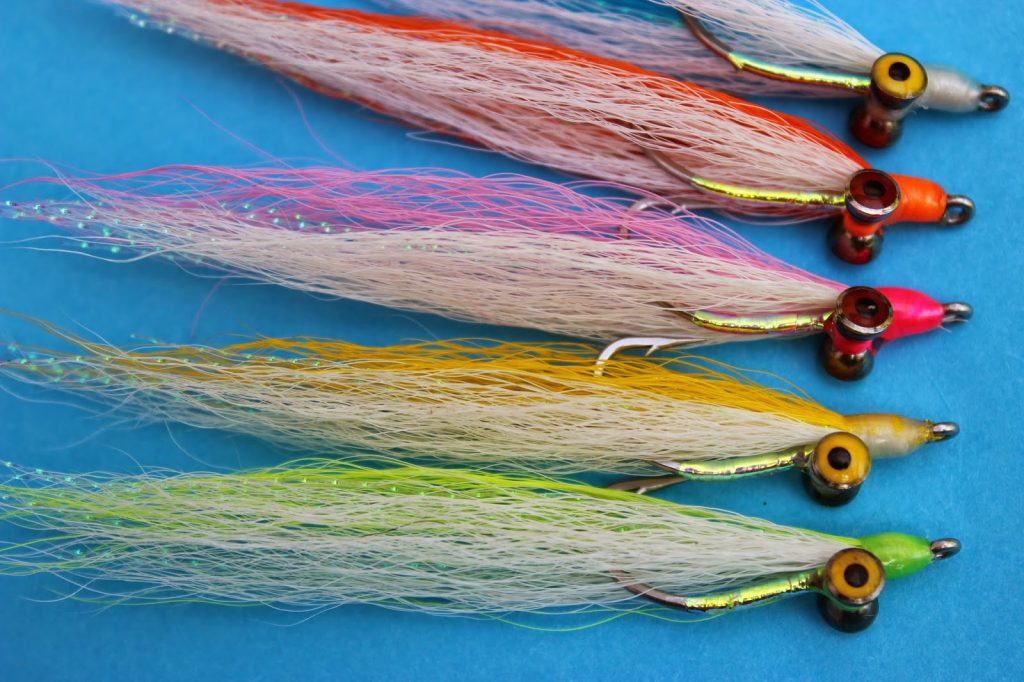
The reason that this fly is so effective is mainly down to the jigging action that is created by the dumbell style eyes, pauses in stripping the fly cause it to dip or jig which makes it look like an injured or dying prey fish. I personally have caught hundreds of fish on this pattern. I always carry a few Clousers in my box in different colours for different situations which I will cover later.
So once you have tied a few Clousers and are feeling more confident you might decide you would like to add a few other patterns to your box, but which one's?
Well, other easy to tie patterns I would recommend are Ray's fly and Brooke's Blond, both of these are classic patterns and again although originally designed with natural materials in mind, they can also be tied with synthetic substitutes, Buckfibre being the best alternative. Again instructions for tying these patterns can be found on the Internet.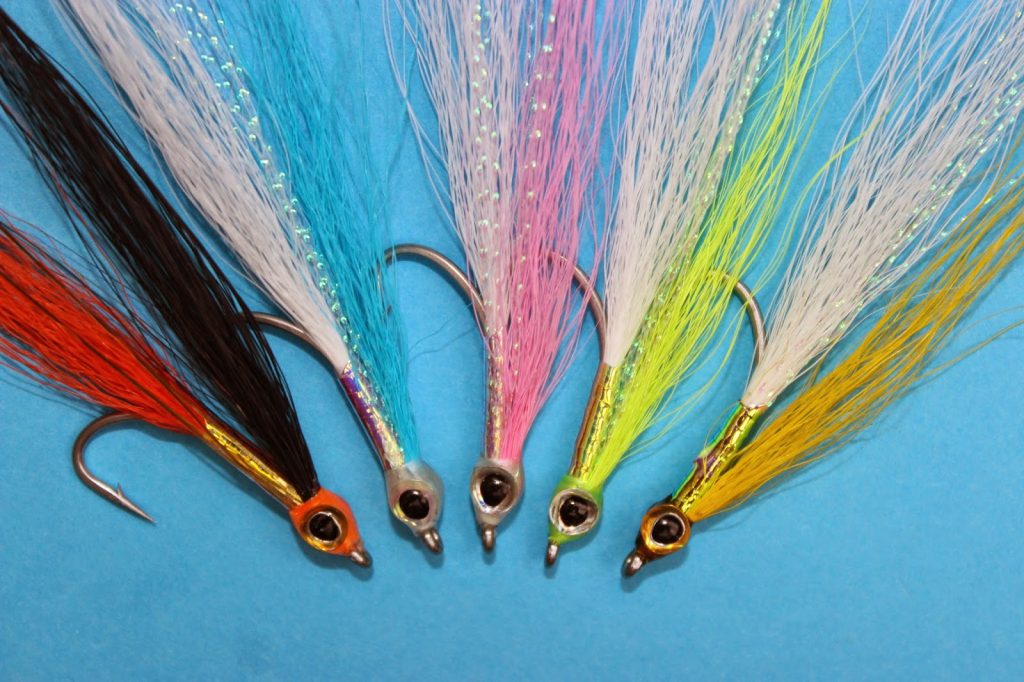
Another favourite of mine is the Surf Candy designed by Bob Popvic's. This is a great pattern that can be tied to represent many inshore baitfish, but in this country a slightly longer profile is a good mimick of Sandeels, which Bass absolutely love. Designed to be tied with synthetics, again you can utilise almost any material to create this pattern.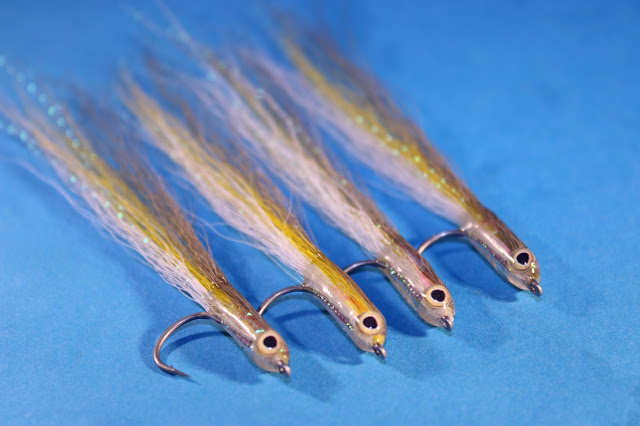
Another pattern that some Saltwater fly anglers favour is Lefty's Deceiver, designed by Lefty krey. Made from Bucktail and feather, and again can be tied with synthetic Bucktail but I find the feather doesn't tend to cast very well and hangs up in the air a bit reducing distance. No doubt it's an effective pattern though and worth having in your box. The Deceiver can be tied wholly from synthetic material such as in Bob Popovic's version which is not only a great looking fly but a very effective fish catcher.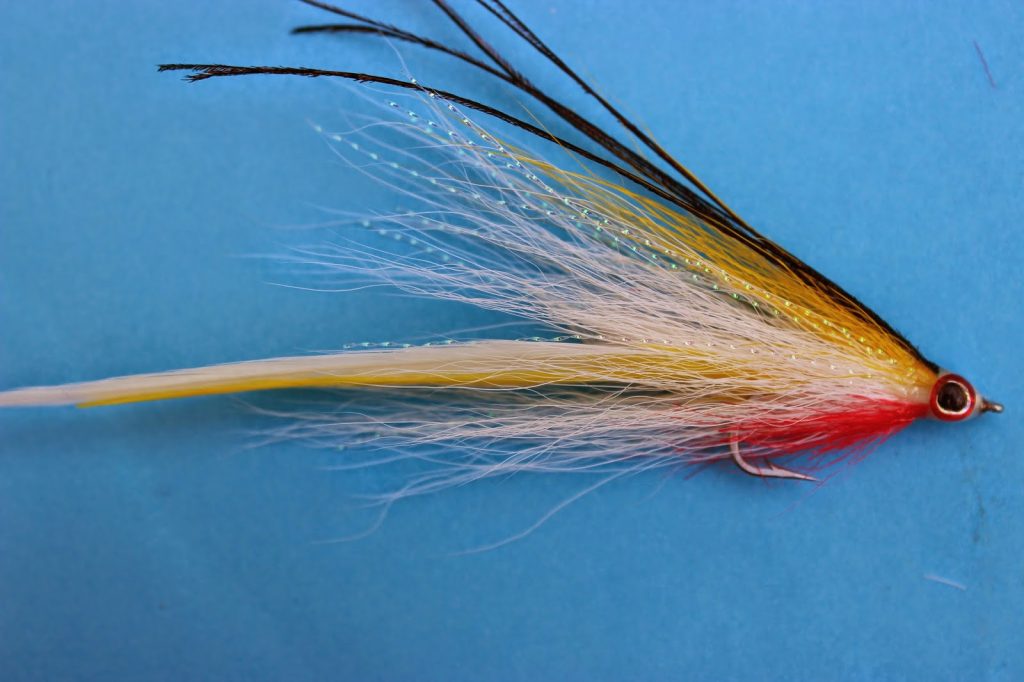
Finally comes Baitfish patterns, such as EP style Baitfish of which you will find a video on the You tube channel. This is the pattern I favour most these days and fish with a large proprtion of the time. Slightly advanced skills are required to tie this pattern effectively and get the right shape but they can be deadly for Bass.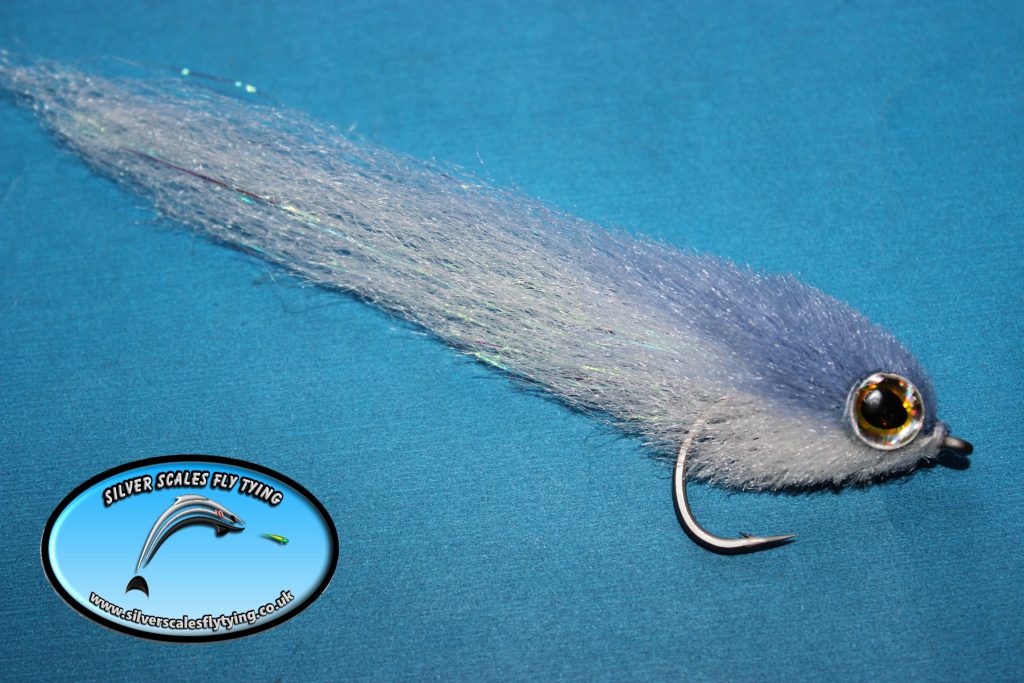
It is always worth purchasing some books on saltwater fly tying, Books by Bob Popovics and Lefty Krey are well worth having and I often refer to them for inspiration in my own tying.
I keep all these patterns of fly in various sizes and colours in my box, from size 6 Clousers for Mackerel and Garfish all the way up to 1/0 in the Baitfish patterns for Bass and Pollock. All tied on Saltwater resistant hooks, be it stainless steel or Nickel, which is actually quite saltwater resistant, you should always rinse your flies and hooks in warm fresh water after use anyway to preserve them keep them in good useable condition.
What colours to tie in and carry in your box is an important subject as colour can be the difference between success and failure on any given day. As a general guide, bright colours for bright days, darker and more natural colours for dull days and strongly contrasting colours for not so clear or murky water conditions. I always tie a colour over a white belly and rarely use solid coloured flies, except when fishing murkier conditions when strong contrasting colours have worked well, i.e Orange over a Black belly. This is just my preference but is not to say that solid colours won't work in clear conditions. Indeed I have caught many fish on solid colours whilst lure fishing but for some reason I've never fished solid coloured flies. The best thing to do on any given day is to assess the conditions and then cycle through various colours until you get a hit. If the optimum stage of the tide has passed and you haven't had a hit then the fish probably are not present and it's time to move on.
Regarding adding flash to flies, this is something I always do and catch plenty of fish as a result, however I do know of very successful anglers that don't add flash to their Bass flies and catch just as well. I think this is down to personal preference as well as confidence. Adding flash may just get the edge on the day but conversely it may make the fish shy away if they are feeling particularly nervous. For me the jury is still out on this subject but my own feeling is I would rather have some flash in the fly to make it a fair representation of a preyfish most of which to be fair, have some kind of shiny reflective appearance to them.
So to summarise if you are new to Saltwater fly fishing and tying, start off with the basics and work you way up. As your skills improve you will be able to progress onto more challenging patterns. Tie up a variety of colours and sizes to try and cover varying conditions. Use the basic rule of thumb of bright day bright fly and dull day dull fly as a starting point and go from there.
There is no doubt tying your own flies and then subsequently catching on them is a very satisfying feeling, and adds to the whole experience that Saltwater fly fishing offers. As previously stated they do not have to be works of art to catch fish, just be a fair representation of a baitfish in the right colour for the given conditions.
Monday, 12 March 2018
Test
hello I'm just testing that the blog is running fine and that I can type ok into the blog area.
Sunday, 11 March 2018
New Saltwater fly season approaching! To tie or not to tie?
https://www.silverscalesflytying.co.uk/wp-content/uploads/2014/04/IMG_1538.jpg
Ok in all honesty it looks like the Saltwater fly season may well arrive a little late this year for those of us who are super keen to make a start, me included! The very cold snap we have recently experienced in this country sent the sea temperatures plummeting setting the arrival of our Saltwater sportfish back by at lease a couple of weeks or more. Sea surface temperatures are probably half what they normally would be for this time of year. Where I live on the South coast on the Isle of Wight, In previous seasons my friends and I have caught Bass as early as mid to late March but more generally the first couple of weeks of April start to produce regularly. Despite this I am optimistic that we will get some milder weather that will hurry things along and regardless it will arrive in a few short weeks. Time to get the kit out and assess what if anything needs attention in preparation for the coming season. Or if you are new to the sport, time to get kit purchased and decide whether you are going to buy ready tied flies or tie your own.
Like any type of fishing, Saltwater fly fishing is a learning curve and it can be a pretty steep one, especially if you want to tie your own flies for the job as well. Saltwater fly fishing is a growing branch of the sport and this is reinforced by the number of new members joining forums and Facebook groups seeking information and guidance and wanting to sample the fantastic sport that 'swffing' can provide. I would always highly recommend tying your own Flies though, not only does it provide enormous satisfaction when you catch fish on your own hand tied flies but you can tailor them to suit varying conditions at your local marks as well as replicate the local baitfish populations which can vary from venue to venue.
If you are new to the sport and are considering tying your own flies please don't think that you need hundreds of pounds worth of materials and tools and an art degree to be able to start tying effective flies! A few simple cheap tools and basic materials are all you need to get you started. How far you take it is up to you. Some are content to just tie a few simple patterns to catch them fish and others progress on to become extremely proficient tiers, tying complex and beautiful works of art. There is no doubt that fly tying is addictive and beware that once you get into it, it can become an obsession! It does help fill the void between seasons though, especially during the long dark nights of winter. A few hours sat at the vice can be extremely theraputic!
For the new tier as already mentioned a few simple, easy to tie patterns are all you need to get started. Look to the Clouser Minnow for probably one of the easiest but most effective flies a newcomer to Saltwater fly fishing can tie. This is the first pattern I ever attempted and whilst my efforts were mediocre at best, I caught well on them. Other simple but effective patterns are Ray's fly and Brooke's Blond. My first ever Bass was caught on a very simple version of a Ray's fly and didn't even have any eyes!
Nowadays I tend to use mostly Baitfish patterns tied with Synthetics but am always happy to tie on one of the more traditional patterns for a change or if I think it may suit the situation.
Bass are not fussy creatures most of the time and are very opportunistic in their feeding. They rarely pause to inspect a bait before snatching it up so don't worry they are giving you points for your tying ability before deciding wether to eat it! The same goes for Mackerel, Pollock and Garfish, the only real consideration is which colour schemes to use on any given day but I will cover this subject more in depth another day. For now some of the most versatile colours are Chartreuse over white, and Olive over White, with Blue, Tan and Grey also all over white being a good bet to have in your box.
So if you are new to Saltwater fly fishing or considering tying your own flies for the job, don't hestitate to give it a go. I am always happy for people to message me and ask questions, either fishing or tying related. Contact me at fishonflies@outlook.com.
In future articles I will delve a little more deeply into Saltwater fly fishing, more about flies and tying, techniques for fishing them and how to locate and present your flies to Bass and other Saltwater species.
Tuesday, 6 March 2018
Fresh stocks of Preyfish fibre and New colours!
A fresh batch of Silver scales Preyfish fibre has just landed and with it six new colours have been added to the range! ( 16 great colours in all ).
Suitable for both Pike and Saltwater flies, create nice bulk without using loads of material making it very economical. Extremely hydrophobic, easily shedding water on the back cast making your flies light and easy to cast!
Check it out here :
https://www.silverscalesflytying.co.uk/product/preyfish-fibre/
